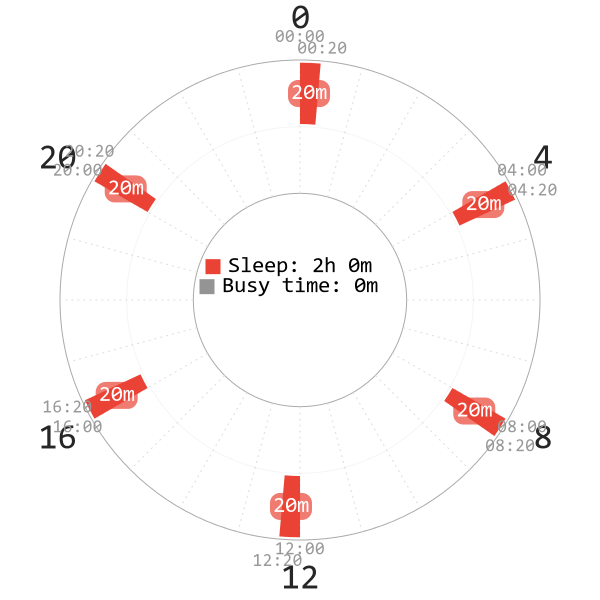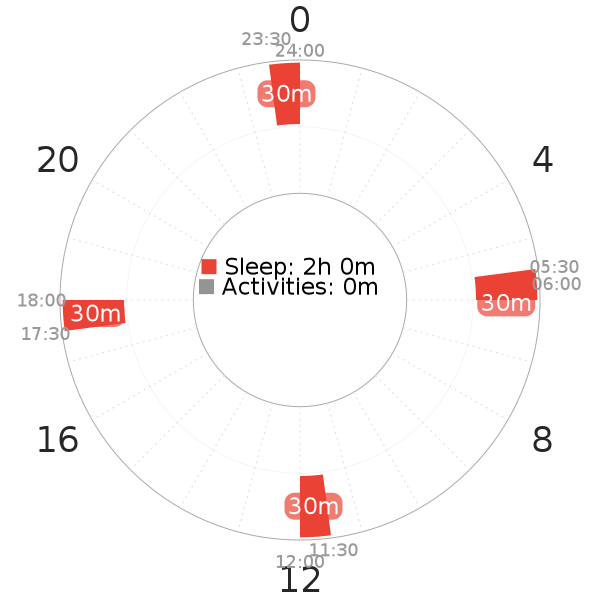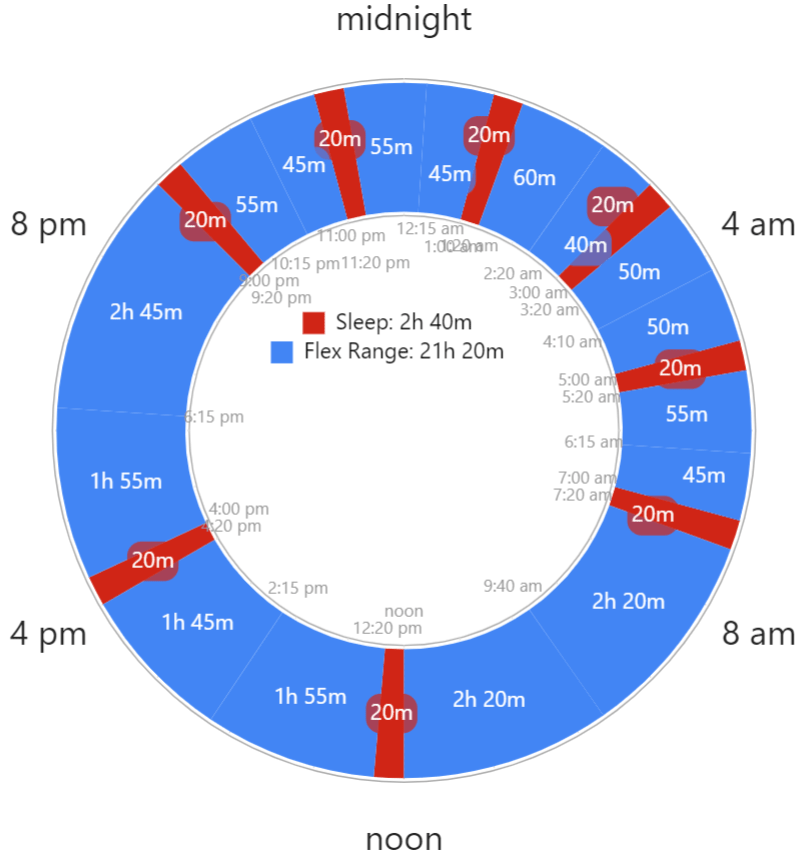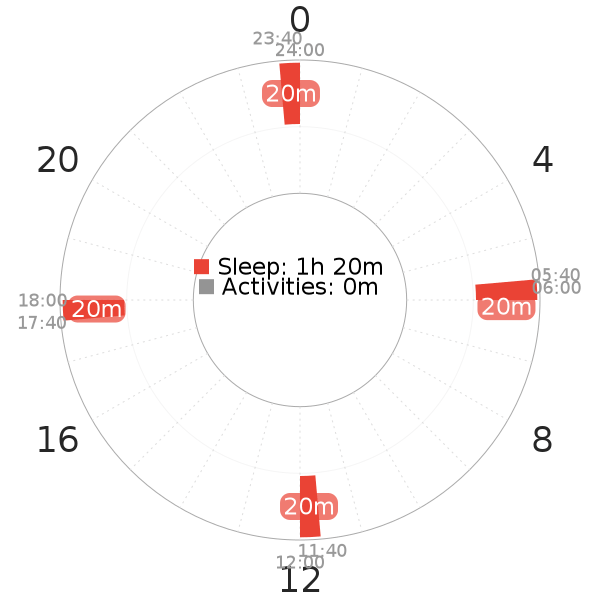NAP-ONLY
Nap-only polyphasic schedules have had quite a long history. They have an outstanding feature of containing only naps (usually up to ~60 minutes). Buckminster Fuller reportedly followed the Dymaxion pattern with only 2 hours of sleep each day in the 1930s.
In the 2000s, Puredoxyk named the Uberman schedule, the most popular nap-only pattern to date. In addition, these schedules are also polar opposites to core-only schedules.
There has also been a lot of research evidence on ultrashort sleep behavior in history. However, nap-only schedules have only lasted for short-term on humans, with possibly controversial interpretations.
- To illustrate, Psychologist J. S. Szymanski researched on the polyphasic sleep behavior in a lot of animals; nevertheless, some of these display nap-only polyphasic tendency.
- In addition, polyphasic sleep researcher Claudio Stampi suggested that humans may be capable of adapting to ultrashort sleep; however, it requires specific conditions and motivations for these schedules to work short-term1.
- Nap-only schedules used to be the definition for polyphasic sleep. However, over the years, the entire scope of polyphasic sleeping does not limit to only these schedules.
Warnings for Average Sleepers
Because these schedules contain only naps, it becomes impossible to an average human (~8h monophasic) to sustain well-being and a viable adaptation. Thus, mostly insomniacs and people with a very reduced sleep requirement would be able to adapt to these extreme schedules.
Even if adaptation is possible, the long-term health impacts on sleepers can potentially be glaring. Therefore, it is unsurprising that there is a sky-high adaptation failure rate for these schedules.
- Nap-only schedules provide the least amount of total daily sleep compared to any other polyphasic schedule groups. This is because their biggest appeal is the massive amount of extra waking hours. As a result, many first-time polyphasic beginners decide to attempt them.
- However, under short-term emergency, they may resort to these schedules to fulfill mandatory commitments.
- Currently, nap-only schedules’ mechanics are under heavy scrutiny. Consequently, inexperienced and average sleepers should NOT attempt these sleep patterns.
Uberman (2 hours)
- Invented by: Puredoxyk
- Alternatively known as: Uber, U6
- Total sleep: 2 hours
- Classification: Nap-only schedule
- Specification: 6 20-min naps
- Mechanism: 6 equidistant naps across the day. There is at least 1 SWS nap and mixed-stage naps are very likely.
- Adaptation difficulty: Extreme
- Ideal scheduling: Time slots are free for rotation. Still, it is advisable to have equidistant nap placement.
Dymaxion (2 hours)
- Invented by: Buckminster Fuller
- Alternatively known as: Dymax, D4
- Total sleep: 2 hours
- Classification: Nap-only schedule
- Specification: 4 naps of 30 minutes each.
- Mechanism: 4 equidistant naps across the day. Namely, circadian spots include: midnight, dawn, noon, and evening. Thus, one should place naps at these spots. There are mixed-stage nap(s) in possibly all 4 naps; however, there are also possibly pure-REM or pure-SWS nap.
- Adaptation difficulty: Extreme
- Ideal scheduling: Arrange naps to fit in 4 aforementioned circadian needs.
Sleep Polyphasically As Much As You Like (SPAMAYL)
- Proposed by: Rasmus
- Total sleep: Undefined, but on average 2.5 hours (7-8 20-minute naps per day)
- Classification: Nap-only schedule, Flexible schedule
- Specification: Multiple short naps
- Mechanism: No rhythm, there have to have more than 6 20-minute naps per day on average.
- Adaptation difficulty: Extreme
- Ideal scheduling: Most naps should be spread during graveyard hours to avoid the need to nap a lot during the day with work, social life, etc.
Tesla (1 hour 20 minutes)
- Invented by: Sharif Olorin
- Alternatively known as: U4
- Total sleep: 1 hour 20 minutes
- Classification: Nap-only schedule
- Specification: 4 naps of 20 minutes
- Mechanism: Variant of Dymaxion with 20 minute naps instead of 30 minute naps. 4 naps per day, equidistantly spread throughout the day. Additionally, circadian spots include: midnight nap, dawn nap, noon nap, and evening nap. Especially, mixed-stage nap(s) may be in all 4 naps, or possibly pure-REM or pure-SWS nap.
- Adaptation difficulty: Insane
- Ideal scheduling: Arranging naps to fit in 4 aforementioned circadian spots.
Comparison between Nap-only Schedules
NOTE:
- The assessment table showcases differences between nap-only schedules, based on standard scheduling. Apparently, there are also other viable options.
- The table accounts for short/insomniac sleepers because of the large majority of successful adaptations come from them.
- Assessment denotations:
- 4/4: Positive, very high viability, or very easy
- 3/4: Somewhat decent viability, above average, or somewhat easy
- 2/4: Neutral, medium viability
- 1/4: Overall negative, low viability, below average, or difficult
| Criteria | Uberman | Dymaxion | SPAMAYL | Tesla |
| Exercising | ||||
| Time zone travel (> 5h) | ||||
| Evening social time (18:00-23:00) | ||||
| Daytime sleep (07:00-17:30) | ||||
| Schedule sleep around meal time | ||||
| Overall flexibility | ||||
| Hidden potential(s) | None | None | Longer nap duration | None |
| Criteria | Uberman | Dymaxion |
| Exercising | ||
| Time zone travel (> 5h) | ||
| Evening social time (18:00-23:00) | ||
| Daytime sleep (07:00-17:30) | ||
| Schedule sleep around meal time | ||
| Overall flexibility | ||
| Hidden potential(s) | None | None |
| Criteria | SPAMAYL | Tesla |
| Exercising | ||
| Time zone travel (> 5h) | ||
| Evening social time (18:00-23:00) | ||
| Daytime sleep (07:00-17:30) | ||
| Schedule sleep around meal time | ||
| Overall flexibility | ||
| Hidden potential(s) | Longer nap duration | None |
Brief Analysis
- Of all nap-only schedules, Uberman is most socially intrusive. This is because it has 3 daytime naps and there is only a 3h40m wake gap in between.
- SPAMAYL is the most flexible prototype and also seemingly the most sustainable. This is largely owing to the higher total sleep to compensate for the highly flexible sleep times. Indeed, the total sleep can reach ~3.5-4h a day, which may be hospitable for long-term sustenance.
- Dymaxion and Tesla, despite having very low total sleep, still has only 2 daytime naps. While they can fit into 9-to-5 occupations, it may eventually become a liability to maintain 2 daytime naps.
- SPAMAYL has the best outlook to survive multi-time-zone travelling occasions once adapted.
- Aside from SPAMAYL, other nap-only schedules have virtually no flexibility even after adaptation.
- Even though it is possible to retain some exercising on nap-only schedules, successful sleepers did report the greatly slowed recovery rate.
- Long-term ultrashort sleep habits are also questionable. There have been Uberman stories where adapted sleepers can potentially sleep for long sessions and crash out of their schedules.
- Barring Uberman, other nap-only schedules have clearer evening social hours. Apparently, this is because they only have short naps rather than core sleeps at these hours.
- All nap-only schedules can be used as emergency sleep reduction techniques for short-term.
- Non-nappers may also resort to any of these schedules to learn to nap, recover on monophasic sleep and attempt an easier polyphasic schedule.
In sum, if nap-only schedules are maintained long-term, it would take an extended period of time to detect possible future sickness or other hidden symptoms.
Main author: GeneralNguyen
Page last updated: 11 January 2021












